Nothing like having your living room covered in gaily colored mounds of drying fiber. I’ve often wondered whether application of an industrial vacuum wouldn’t make the job easier, just suck everything up and start tying flies out of the contents of the dust trap.
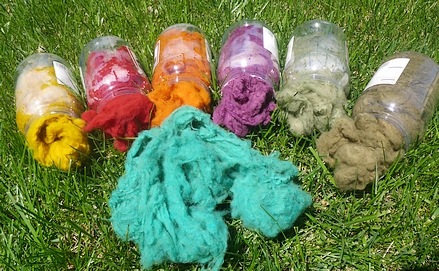
Above are the raw elements of spectral dubbing, consisting of the primary colors of the color spectrum; red, cyan (Lt. blue), and yellow – and the secondary colors – orange, purple, and green. Only the cyan and yellow are acid dyed, the rest of the colors were built using RIT dye.
I’ve added a pound of Olive on the end as a tertiary color. I’ll add it to natural colored fur blends to make Olive tints to the original color.
It’s a raw mix of of natural fur that will replace the more expensive (and hard to find) Australian Opossum. A mainstay of my custom blends, Australian Opossum is imbued with tiny curls that retain air, adds loft and resists matting. Unfortunately, our American Opossum lacks those qualities and cannot be used as a substitute.
The spectral effect is the addition of all these colors to a base dubbing in small enough amount so as not to be seen until examined closely. At arm’s length, an Olive dubbing looks Olive – until you hold the fly close and can make out the individual colored fibers contained in the mixture.
It’s one of many building blocks of the Impressionist fly tyer, how to make a fly resemble nothing specific, yet look like everything – and all at the same time. Part of that magic is style and form, part is color.
Spectral dubbing blends should follow the 90/10 rule. 90% of the fur is the color you are attempting to imbue and 10% is the brightly colored fibers that will add a bit of deceit to the final product.
Building the Chaos color
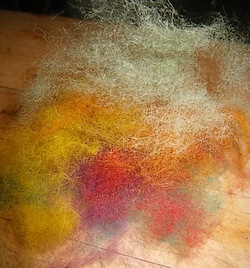 The simplest way to build a good spectral effect is build the “Chaos” color and simply add it to your base fur in the desired quantity.
The simplest way to build a good spectral effect is build the “Chaos” color and simply add it to your base fur in the desired quantity.
Add equal amounts of each of the six primary and secondary colors, and mix it into a single color. This is the Chaos color.
Now you can grab a pack of Hareline dubbing off the vendors wall, pinch in 10% – and blend your final product.
Add a bit of opalescent sparkle or other effects if desired.
Above are equal pinches of the six colors. Because it’s a “sticky” fur due to the tiny curls, this will not blend well using an electric blender. It’ll knot itself into clumps of color rather than mix completely.
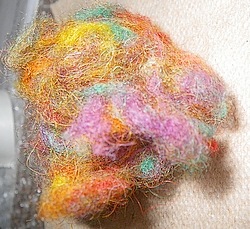 At right is the knotted mass that came out of the blender. It mixed the colors slightly, but the bulk of the mixture is still clumped color and undesirable.
At right is the knotted mass that came out of the blender. It mixed the colors slightly, but the bulk of the mixture is still clumped color and undesirable.
Non-sticky fibers, those that are straight and lack adhesion, like rabbit – will blend easily, but a good filler candidate is rarely straight, as it’s chosen exactly for this sticky quality.
If you’re building small amounts of fur, a pair of dog grooming wire brushes are needed. Just load both brushes with plenty of fur and pull them in opposite directions numerous times until you approve the result. Larger amounts are better served by mixing them with water, fill a gallon jug about half full and cram the fur inside, shake until it’s a cohesive colored mass.
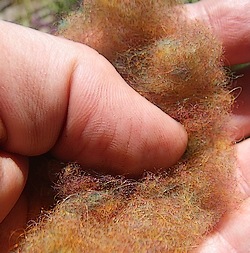
A well mixed Chaos color; equal parts red, yellow, cyan, green, purple, and orange, creates a red-brown or a “Russet Brown” shown at left.
Tuck that away in a separate bag and add to your base blends to color as needed.
Constructing the Final Blend
The amount shown at left is 10% of what I’ll build, to finish the task we’ll add that handful to 90% more of a standard olive blend.
Because I built both a spectral color and it’s a filler fiber, all I need is binder and wrapper in Olive to make my final mixture.
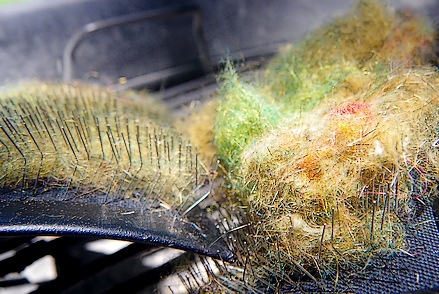
I loaded the Chaos color on one brush and a mixture of medium olive beaver (binder) and natural Red Fox squirrel body (guard hairs, wrapper) on the other. Just put the teeth of the combs together and yank in opposite directions enough times to mix the two. Eventually all the hair will wind up on one brush, just pull it off and reload the combs as many times as needed.
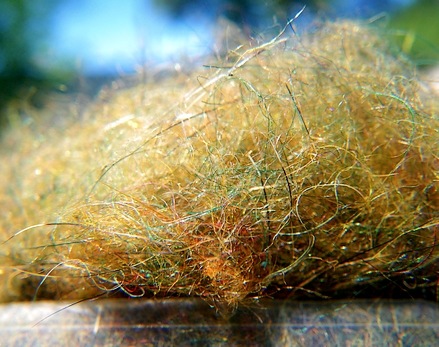
Above is a close-up of the final mix. It’s a medium olive imbued with the spectral Chaos color. The natural guard hairs are visible as are individual shafts of component color. At two feet, it’s just another olive, but up close almost any color combination is visible.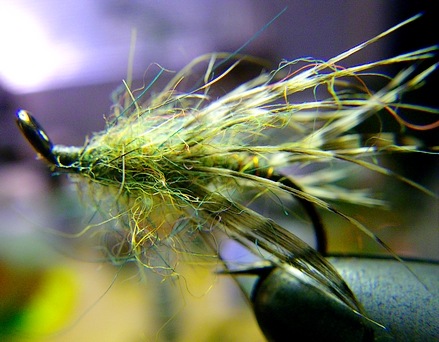
… which is the desired effect. A dominant base color and just enough of an accompaniment from the mixed primary and secondary colors to assist without overwhelming everything.
Tags: dubbing blends, bulk fly tying materials, spectral dubbing, Red Fox Squirrel, impressionism, primary and secondary color, artist’s color wheel, fly tying

From chaos comes beauty. I wish that I had the patience, time and desire to try creating my own tying materials!
K…have you gotten any emails from me?
Monty
Pingback: Tweets that mention Anatomy of a spectral blend | Singlebarbed -- Topsy.com